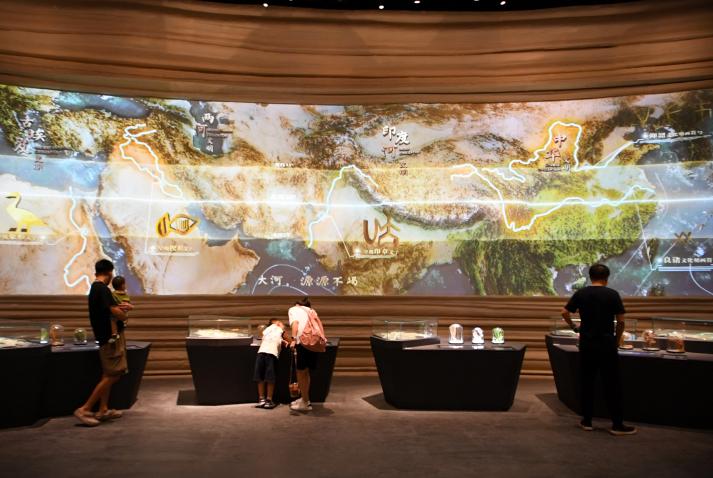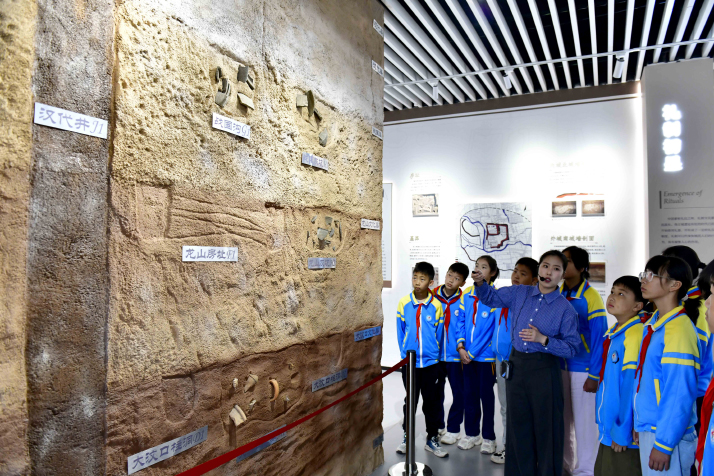| China |
| The rise of national archaeological parks—where relics aren't just displayed but also experienced | |
|
|
 A digital display at the Dahecun Site Museum in Zhengzhou, Henan Province, on June 14 (XINHUA)
With a civilization spanning millennia, China has long been a custodian of profound historical heritage. In recent years, alongside the establishment of museums, the country has accelerated efforts to develop national archaeological site parks—innovative spaces that transform excavation sites into immersive classrooms. These parks not only preserve ancient relics but also invite the public to engage with the research process, bridging the gap between academia and popular understanding. While museums curate artifacts behind glass, archaeological parks offer a dynamic alternative: sprawling landscapes where visitors walk amid reconstructed ruins, participate in simulated digs and witness ongoing research. This hands-on approach demystifies the past, contrasting with traditional exhibits by emphasizing context and fostering a tangible connection to bygone eras. On June 14, the National Cultural Heritage Administration (NCHA) announced the addition of 10 national archaeological site parks, bringing the total number to 65 across 21 provinces, autonomous regions and municipalities. The newly added parks span, among other provinces, Shaanxi, Henan, Shandong and Anhui, as well as Inner Mongolia Autonomous Region. "The 10 newly designated parks showcase pivotal achievements in human evolution, agricultural origins, the early formation of states and civilizations, and the development of Chinese culture. They highlight both the historical significance of Chinese civilization and the spiritual ethos of the Chinese nation," an NCHA official told Xinhua News Agency following the announcement. "These parks have achieved the holistic conservation of their historical settings and archaeological remains, innovated their exhibitions with high-quality displays, and hosted different cultural, academic and public engagement activities," the official added.  Students visit the Yaowang City Archaeological Site Park in Rizhao, Shandong Province, on May 23 (XINHUA)
Diversified development Henan, often hailed as the "cradle of Chinese civilization," holds an unrivaled position in China's ancient history. As the heartland of the Yellow River Basin, it nurtured the earliest dynasties in Chinese history, including the Shang Dynasty (1600-1046 B.C.), whose oracle bones bear China's earliest systematic writing. Among the newly designated parks is the Dahecun National Archaeological Site Park in Henan. Located in northeast Zhengzhou, the provincial capital, the 960-hectare park features three key zones: a new Dahecun Site Museum, an ecological restoration area and a core heritage exhibition space. It is Zhengzhou's third national archaeological site park, joining the Ancient Capital City of Zheng and Han States National Archaeological Site Park and the Zhengzhou Ancient Shang City Archaeological Site Park. Centered on the Dahecun ruins and the Yangshao Culture (5000-3000 B.C.), the park integrates site preservation, archaeological research, cultural education and public recreation, creating a lively window into Neolithic China. Dating back some seven millennia, the Yangshao Culture pioneered painted pottery and featured early agricultural villages with semi-subterranean homes. Key sites like Banpo in Xi'an, Shaanxi Province, and Dahecun reveal advanced tools, millet farming and clan-based social structures. "The Dahecun National Archaeological Site Park project aligns with China's national strategy for ecological conservation and high-quality development in the Yellow River Basin," Hu Jizhong, Curator of the Dahecun Site Museum, told local newspaper Zhengzhou Daily. "On the one hand, it prioritizes the preservation of the Yellow River's cultural heritage; on the other, it emphasizes ecological restoration across the basin. The park's master plan, new museum design and exhibitions all reflect high-standard planning and construction," Hu said. Hu added that the park will play a pivotal role in advancing high-quality cultural tourism in Henan. Unlike Henan's archaeological parks, which highlight the agricultural civilizations of the Yellow River Basin, Inner Mongolia's newly listed Salawusu National Archaeological Site Park and Helingeer Tuchenzi National Archaeological Site Park preserve traces of historical integration between nomadic and farming cultures. With these additions, Inner Mongolia now boasts three national archaeological site parks. The Salawusu Site, located in Uxin Banner, Ordos City, is one of the earliest excavated Paleolithic sites in China. Covering over 1,700 hectares, the site has yielded fossils of the Hetao people dating back 50,000 to 100,000 years, along with finely crafted stone tools and abundant mammalian fossils. It offers fundamental evidence for studying and understanding the evolution of East Asian hominids, their living environments during the middle to late Paleolithic period, and the cultural diversity and development of Paleolithic societies in north China. One of the best-preserved ancient city ruins in Inner Mongolia, the Helingeer Tuchengzi Site spans a history of more than 2,000 years, from the Spring and Autumn Period (770-476 B.C.) to the Liao (907-1125), Jin (1115-1234) and Yuan (1271-1368) dynasties. It is a testament to the historical interplay between the agrarian civilizations of the Central Plains and the nomadic cultures of north China, as well as the governance system of the central government in border areas. The site will be developed into a cultural landmark integrating research, education and recreation. "The successful inclusion of these two archaeological sites further enhances Inner Mongolia's cultural heritage preservation framework, injecting fresh momentum into the in-depth study of northern frontier culture and regional socio-economic development," Zhi Xiaoyong, Deputy Director of Inner Mongolia's Cultural Heritage Administration, told China News Service. Counting the benefits Over the past decade, China's national archaeological site parks have emerged as pivotal platforms for advancing the nation's cultural development strategy. Their construction has been incorporated into the 14th Five-Year Plan (2021-25) for National Economic and Social Development and the Long-Range Objectives Through the Year 2035, adopted in 2021 and outlining China's goal of "basically achieving socialist modernization" by 2035, underscoring their role in long-term cultural governance. To bolster this initiative, the National Development and Reform Commission has prioritized these parks under its Cultural Heritage Conservation and Utilization Project, providing funding and policy support. Meanwhile, the Ministry of Natural Resources and the Ministry of Agriculture and Rural Affairs have both issued guidelines on allocating land for park development. At the local level, 15 provincial governments have designated or planned 193 provincial-level archaeological site parks, reflecting growing institutional commitment. On the legal and institutional front, China's newly revised Law on the Protection of Cultural Relics, which came into force in March, has formally granted legal recognition to archaeological site parks, with specific provisions aimed at driving institutional reforms, facilitating archaeological research and its practical application while boosting the parks' capacity to deliver cultural services to the public. With strong policy support, China's national archaeological site parks saw remarkable growth in 2024, according to data from the NCHA. Last year, total ticket revenue reached 1.83 billion yuan ($252 million), a 194-million-yuan ($27-million) increase from 2023, and creative cultural product sales surged by 50 percent year on year to 55.4 million yuan ($7.7 million). The parks organized an accumulative of 1,339 public events, attracting 5.3 million more participants than the previous year. Annual visitor numbers jumped by 32 percent to 88.7 million, with 56.08 percent of visitors enjoying free admission. "National archaeological site parks represent our era's response to cultural heritage preservation and innovation," He Zhenhua, Deputy Director of the Sichuan Provincial Cultural Heritage Administration, said at the opening ceremony of the Sixth National Archaeological Site Park Culture and Arts Week, which was held in Guanghan, Sichuan Province, on April 27. "Guided by the principles of sustainable utilization, innovation-driven development and integrated growth, we will continue advancing the conservation and revitalization of major heritage sites. Our goal is to breathe new life into these cultural treasures across the land, ensuring they contribute meaningfully to cultural continuity and socio-economic progress," He added. Copyedited by Elsbeth van Paridon Comments to zhangyage@cicgamericas.com |
|
||||||||||||||||||||||||||||
|